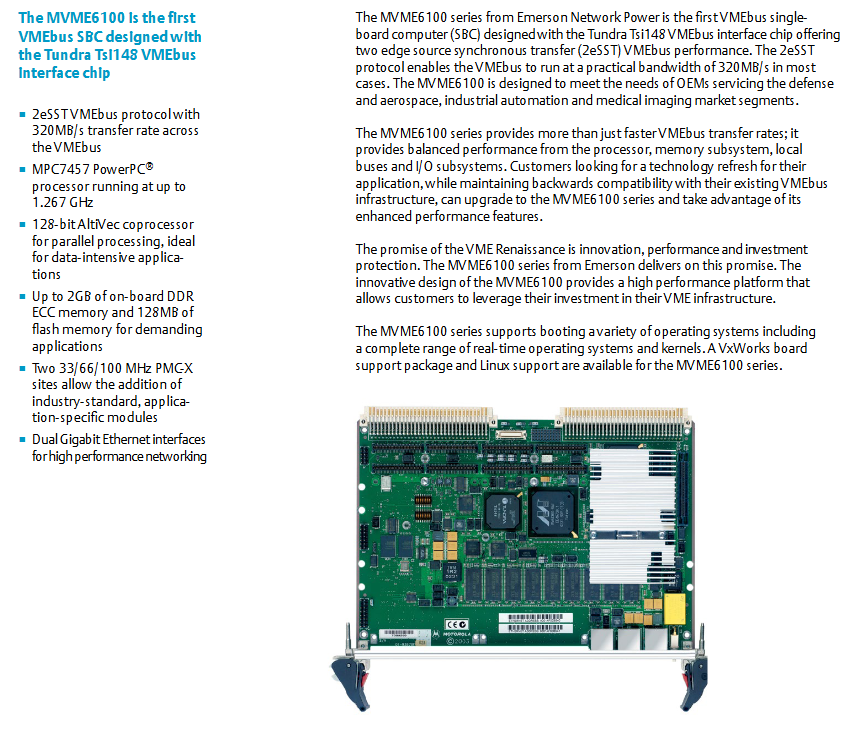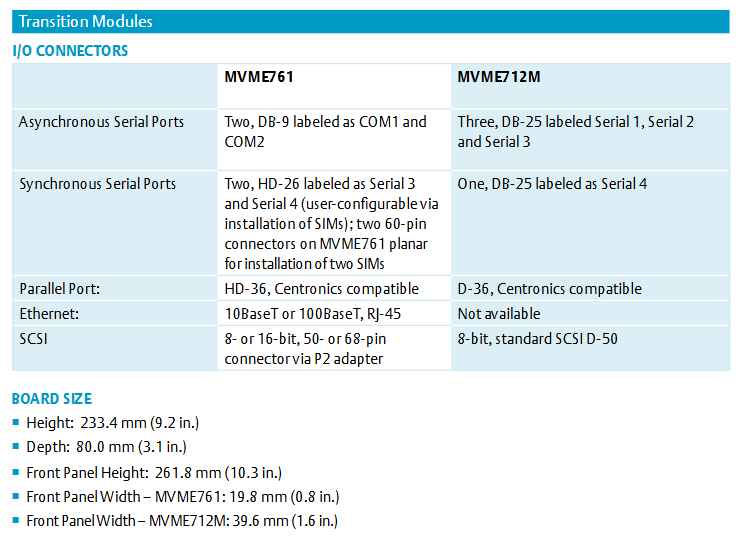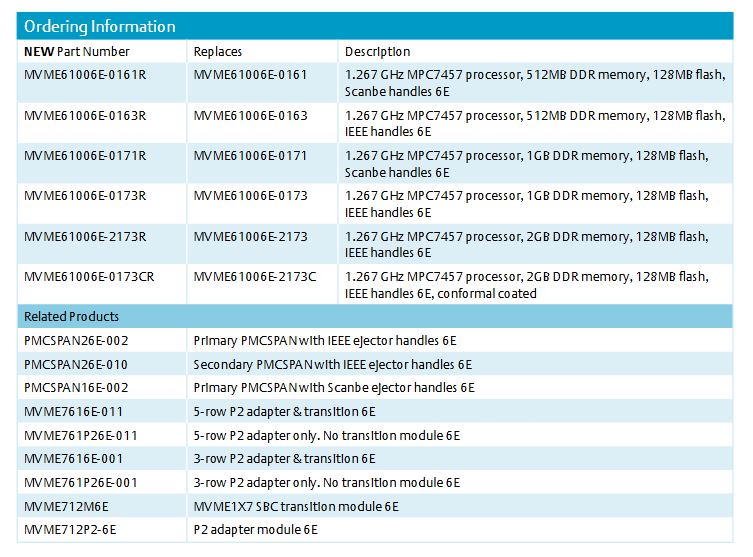Emerson MVME6100 series VMEbus single board computer
Emerson MVME6100 series VMEbus single board computer
Product positioning and core values
The MVME6100 series is the first VMEbus single board computer (SBC) launched by Emerson Network Power, which uses the Tundra Tsi148 VMEbus interface chip and focuses on "business critical continuity embedded computing". Its core advantage lies in achieving a bus transmission rate of 320MB/s through the 2eSST VMEbus protocol, while balancing the performance of the processor, memory, local bus, and I/O subsystem. It can meet the high reliability and high bandwidth embedded computing needs of defense aerospace, industrial automation, medical imaging, and other fields, and is compatible with existing VMEbus infrastructure to protect users' existing investments.

Core hardware specifications
(1) Processor and computing power
Component parameter details
Main processor MPC7457 PowerPC ® Processor, maximum clock speed 1.267GHz
128 bit AltiVec coprocessor, supporting parallel processing, suitable for data intensive applications
Cache configuration on-chip L1 cache (instructions/data): 32K/32K; On chip L2 cache: 512K; L3 cache: 2MB
(2) Storage system
Storage type parameter details
Main memory DDR ECC SDRAM, speed 133MHz (DDR266), maximum capacity 2GB (onboard), supports 512MB/1GB/2GB configurations
128MB onboard programmable EEPROM flash memory, divided into two 64MB storage banks, supporting jumper write protection
Non volatile memory (NVRAM) capacity of 32KB (user usable 4KB), storage life of 50 years at 55 ° C, service life of 5 years at 100% duty cycle at 25 ° C, equipped with replaceable battery
(3) Bus and Interface
VMEbus interface
Protocol compatibility: ANSI/VITA 1-1994 (VME64), ANSI/VITA 1.1-1997 (VME64 extension) VITA 1.5(2eSST)
Transmission performance: Under the 2eSST protocol, the actual bandwidth reaches 320MB/s
Function support: DTB main device (A16/A24/A32/A64 addresses, D08-D64 data, supporting SCT/BLT/MBLT/2eVME/2eSST); DTB from equipment (including UAT function); RR/PRI Arbitrator; 7-way IRQ interrupt processing/generation; System controller with jumper or automatic detection capability; 2 LMA32 position monitors
Compatibility: Equipped with Texas Instruments' new VMEbus transceiver, it can be connected to standard VMEbus backboards and is compatible with existing VMEbus boards, backboards, chassis, and software
PCI and Expansion Interface
2 33/66/100 MHz PMC-X slots: support industry standard PMC/PrPMC modules, expandable for application specific functions (such as multiprocessors)
32/64 bit 33/66 MHz PCI expansion interface: supports PCI expansion carriers such as Emerson PMCSpan
64 bit/133 MHz PCI-X bus: connects Tsi148 VMEbus interface chip with PMC-X slot to ensure high bandwidth transmission
network interface
Dual Gigabit Ethernet interface, controller integrated into host bridge, speed 10/100/1000Mbps
Connection method: 1 router to front panel RJ-45, 1 can be routed to front panel RJ-45 or P2 interface (10/100Mbps router to MVME761 RJ-45 in IPMC mode, gigabit router to P2 in PMC mode)
serial interface
Asynchronous serial ports: 2 16550 compatible ports, EIA-574 DTE configuration, maximum baud rate of 38.4Kbps (EIA-232)/115Kbps (raw rate), 1 routed to front panel RJ-45, 1 used for development
Extended serial port (requires IPMC module): IPMC761 provides 2 asynchronous+2 synchronous ports, IPMC712 provides 3 asynchronous+1 synchronous port, supports EIA-232/DCE/LTE configuration
Other interfaces
Parallel port: Supports IEEE 1284 standard (MVME761 for HD-36 interface, MVME712M for D-36 interface, Centronics compatible)
SCSI interface: The IPMC module is equipped with Symbios 53C895A controller, supporting 8-bit (5.0MB/s asynchronous) and 16 bit (20.0MB/s Ultra SCSI), and needs to be connected through a P2 adapter
Software support
(1) Firmware and Debugging
Onboard firmware (MOTLoad): stored in flash memory, providing power on self-test (POST), system initialization, and operating system boot functions, supporting debugging interfaces similar to "bug" (compatible with OEM VMEbus boards)
(2) Operating System
Support real-time operating system (RTOS) and kernel: Provides VxWorks board level support package (BSP), Lynx OS BSP, and Linux system support
(3) Library and Protocol
BETA 4.0 NDDS (real-time publish/subscribe middleware) supporting Real Time Innovations (RTI), which can run through Gigabit Ethernet or native VME; NDDS 4.0 under the 2eSST protocol can be obtained through Emerson bundled models
Key functions and features
(1) Performance balance
The host bridge (Marvel MV64360) supports 133MHz host bus and 133MHz DDR memory bus, matching processor speed; Dual PCI-X buses are respectively connected to the VMEbus interface and PMC slot to avoid bandwidth bottlenecks
(2) Backward compatibility
It can be migrated from Emerson's previous generation products (MVME2300/2400 controllers, MVME2600/2700/5100/5500 SBC), compatible with existing hardware (such as VME backboards, I/O modules) and software, simplifying the upgrade process
(3) P2 I/O mode and transition module
P2 I/O mode (jumper configuration)
PMC mode: compatible with MVME2300/2400/5100/5500, P2 interface provides 64 pin deep I/O for PMC slot 1 and 46 pin deep I/O for slot 2
IPMC mode: When inserting the IPMC761/712 PMC card, it supports MVME761/MVME712M legacy I/O modules (PMC I/O function is limited), and PMC slot 2 is reserved for expanding SCSI signals
Transition module
MVME761: Provides IEEE 1284 parallel port, 10/100BaseT Ethernet (RJ-45), 2 DB-9 asynchronous serial ports (EIA-574 DTE), 2 HD-26 synchronous/asynchronous serial ports (EIA-232/DCE/LTE can be configured through SIM), requiring 3/5 rows of P2 adapters (5 rows support 16 bit SCSI)
MVME712M: Provides Centronics parallel port, narrow SCSI port, 4 DB-25 asynchronous/synchronous serial ports (with jumper configuration EIA-232), 5 rows of P2 adapters supporting additional user-defined I/O
(4) Environmental adaptability and reliability
Environmental parameter operating status Non operating status
Temperature: 0 ° C~+55 ° C (intake temperature under forced air cooling) -40 ° C~+85 ° C
Humidity (non condensing) 5%~90% 5%~90%
Vibration 6 Gs RMS (20-2000 Hz random) 6 Gs RMS (20-2000 Hz random)
Mean Time Between Failures (MTBF) in a ground fixed uncontrolled environment: 178403 hours; Ground benign controlled environment: 328698 hours
Safety compliance: Printed Circuit Board (PWB) flame retardant rating UL 94V-0
EMC Compliance: Compliant with FCC Part 15 Subpart B Class A (USA), ICES-003 Class A (Canada), EU EMC Directive 89/336/EEC (EN55022 Class A emission, EN55024 immunity)

Applicable fields and values
(1) Defense and Aerospace
Adaptation scenarios: shipborne shielding systems, ground fixed systems, reconnaissance aircraft command and control applications
Core value: 1.267GHz processor+100MHz PMC bus+8x VME bandwidth, eliminating bottlenecks in traditional command and control systems; Support PrPMC expansion for multiple processors without the need for additional heat dissipation and I/O management; Compatible with existing VME infrastructure, reducing upgrade costs
(2) Industrial automation
Adaptation scenarios: Semiconductor Processing Equipment (SPE), Automatic Test Equipment (ATE), High end Industrial Control
Core value: High bus bandwidth and processing speed improve production efficiency; AltiVec technology supports vector processing; Dual PMC slots with customizable functionality; Backward compatibility ensures reuse of existing devices (such as sensors and actuators)
(3) Medical imaging
Adaptation scenarios: Nuclear Medicine (NM), Positron Emission Tomography (PET), Magnetic Resonance Imaging (MRI), X-rays, Computed Tomography (CT)
Core value: 2eSST protocol increases VME transmission rate by 8 times, meeting the requirements of image intensive computing; Compatible with existing VME systems to protect software and hardware investments; Reduce the number of embedded boards and alleviate equipment space pressure
Product specifications and ordering information
(1) Physical specifications
Dimension parameters
Height 233.4 mm (9.2 in.)
Depth 160.0 mm (6.3 in.)
Front panel height 261.8 mm (10.3 in.)
Width 19.8 mm (0.8 in.)
Maximum component height 14.8 mm (0.58 in.)
Weight Scanbe handle: 425 g (15 oz.); IEEE controller: 468 g (16.5 oz.)
(2) Power requirements (excluding PMC/IPMC modules)
Input voltage:+5V ± 5%
Current: MVME6100 single machine - typical 8.4A, maximum 10.2A; MVME6100+MVME761- typical 9.2A, maximum 11.2A
IPMC module additional power consumption:+5V maximum 0.5A,+3.3V maximum 0.75A (IPMC761/IPMC712 universal)
(3) Ordering model (main model)
New model replacing old model description
MVME61006E-0161R MVME61006E-0161 1.267GHz MPC7457512MB DDR, 128MB flash memory, Scanbe controller
MVME61006E-0163R MVME61006E-0163 1.267GHz MPC7457512MB DDR, 128MB flash memory, IEEE controller
MVME61006E-0171R MVME61006E-0171 1.267GHz MPC7457, 1GB DDR, 128MB flash memory, Scanbe controller
MVME61006E-0173R MVME61006E-0173 1.267GHz MPC7457, 1GB DDR, 128MB flash memory, IEEE controller
MVME61006E-2173R MVME61006E-2173 1.267GHz MPC7457, 2GB DDR, 128MB flash memory, IEEE controller
MVME61006E-0173CR MVME61006E-2173C 1.267GHz MPC7457, 2GB DDR, 128MB flash memory, IEEE handle, conformal coating (corrosion-resistant)
(4) Related accessories
PMCSPAN series: PMCSPN26E-002/010 (IEEE controller), PMCSPN16E-002 (Scanbe controller)
P2 Adapter and Transition Module: MVME7616E-011 (5-Row P2 Adapter+Transition Module), MVME761P26E-011 (5-Row P2 Adapter Only), MVME7616E-001 (3-Row P2 Adapter+Transition Module), MVME761P26E-001 (3-Row P2 Adapter Only), MVME712M6E (Transition Module), MVME712P2-6E (P2 Adapter)

- EMERSON
- Honeywell
- CTI
- Rolls-Royce
- General Electric
- Woodward
- Yaskawa
- xYCOM
- Motorola
- Siemens
- Rockwell
- ABB
- B&R
- HIMA
- Construction site
- electricity
- Automobile market
- PLC
- DCS
- Motor drivers
- VSD
- Implications
- cement
- CO2
- CEM
- methane
- Artificial intelligence
- Titanic
- Solar energy
- Hydrogen fuel cell
- Hydrogen and fuel cells
- Hydrogen and oxygen fuel cells
- tyre
- Chemical fiber
- dynamo
- corpuscle
- Pulp and paper
- printing
- fossil
- FANUC
- Food and beverage
- Life science
- Sewage treatment
- Personal care
- electricity
- boats
- infrastructure
- Automobile industry
- metallurgy
- Nuclear power generation
- Geothermal power generation
- Water and wastewater
- Infrastructure construction
- Mine hazard
- steel
- papermaking
- Natural gas industry
- Infrastructure construction
- Power and energy
- Rubber and plastic
- Renewable energy
- pharmacy
- mining
- Plastic industry
- Schneider
- Kongsberg
- NI
- Wind energy
- International petroleum
- International new energy network
- gas
- WATLOW
- ProSoft
- SEW
- wind
- ADVANCED
- Reliance
- YOKOGAWA
- TRICONEX
- FOXBORO
- METSO
- MAN
- Advantest
- ADVANCED
- ALSTOM
- Control Wave
- AB
- AMAT
- STUDER
- KONGSBERG
- MOTOROLA
- DANAHER MOTION
- Bently
- Galil
- EATON
- MOLEX
- Triconex
- DEIF
- B&W
- ZYGO
- Aerotech
- DANFOSS
- KOLLMORGEN
- Beijer
- Endress+Hauser
- MOOG
- KB
- Moxa
- Rexroth


Email:wang@kongjiangauto.com
























































































































